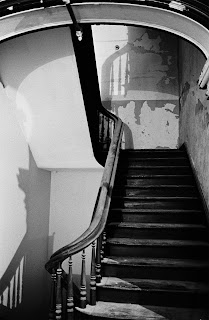A few blog posts back, I mentioned that I was working on multiple projects; projects which had no set completion date; projects that might take a few years until I feel they're complete and ready for public viewing. I recently completed the second photo shoot for one of those projects. This project, in its' entirety, is far from completion; however, I want to talk about the recent shoot and share a few images. This will provide me with an outlet to discuss the project at various stages as well as provide you with a sneak peak into some of the images.
In June of this year, I visited the Mansfield Reformatory. It was a wonderful photographic journey which I shot entirely on Kodak Tri-X 400 black and white film. The reformatory and the experience I had photographing it inspired me to continue with that work. The research began and I started compiling a list of abandoned prisons and mental institutes that I would like to photograph. I'll be shooting these facilities on a variety of cameras, but I'll only be using Kodak Tri-X 400 film. The goal is to tell a story about each of these buildings through my final images as well as providing a look into the history of the correctional process of our nation. I'm not sure when this will be complete, but I can tell you that I do have another institute lined up before the end of the year.
On September 25, Brittany and I traveled to Weston, West Virginia. Weston is a very small town about 5.5 hours from Troy, Ohio. It's approximately 50 miles south of Morgantown. There's not much there, sans three hotels, a Walmart, a few fast food restaurants, a quaint downtown and a massive European structure known as the Trans-Allegheny Lunatic Asylum. According to their website, the Trans-Allegheny Lunatic Asylum was constructed between 1858 and 1881 and is the largest hand-cut stone masonry building in North America and is reportedly the second largest in the world, only behind the Kremlin. Richard Andrews designed the structure according to the Kirkbride plan (which influenced over 300 similar institutions over North America) and the original hospital was meant to hold 250 individuals. It opened to patients in 1864 and reached its' peak in the 1950s with 2,400 patients. In fact, it is rumored that Charles Manson actually spent some time at the facility, but there is no official record. Apparently the administrators used an alias for him because the community was outraged at the prospect of him being brought to the facility. Trans-Allegheny Lunatic Asylum was eventually closed in 1994; this was a mortal blow to the local economy and it's obvious that it's never quite recovered.
This structure is quite eerie, yet strikingly beautiful. I had scheduled 8 hours of shooting on Sunday; the first four to begin at 8 a.m. and end at 12 p.m. The final four from 2-6 p.m. We pulled up to the asylum around 7:20 a.m. and a heavy layer of fog surrounded the building. It was the perfect setting for exploring this abandoned treasure all day. My photography tour covered the main hospital, the grounds, the medical building, the geriatric building, the forensics facility and the women's center. All areas were in a complete state of decay, the outlying buildings more so than the hospital. Paint was peeling from the walls and ceilings, floors were reduced to dirt, ceiling tiles were hanging by a thread and debris was scattered everywhere. It's completely cliche, but if walls could talk in that facility, I'm sure they would have stories upon stories to tell. This structure was as I expected and it was the perfect follow-up to my Mansfield Reformatory shoot. I am very pleased with the images and I look forward to exploring more of these facilities as I continue with this project. For now, I've included a few of my final images.









No comments:
Post a Comment